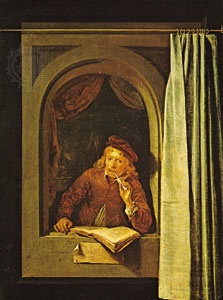Dou, Gerrit
Dutch painter
Gerrit also spelled Gerard
born April 7, 1613, Leiden, Neth.
died Feb. 9, 1675, Leiden
 Dutch Baroque painter, leading artist of the school of Leiden, especially known for his domestic genre paintings and portraits.
Dutch Baroque painter, leading artist of the school of Leiden, especially known for his domestic genre paintings and portraits.He was first trained by his father, a glazier and glass engraver. From 1628 to 1631 he studied with Rembrandt, adopting the master's choice of subject matter and his use of impasto, careful draftsmanship, and dramatic treatment of light and shadow; e.g., “Rembrandt's Mother” (c. 1630; Rijksmuseum, Amsterdam). After Rembrandt left Leiden in 1631, his influence on Dou gradually weakened. Dou continued to paint on wood in a small scale, often enclosing his works in specially made cases, which he decorated. The portraits of his Rembrandtesque phase gave way to a predominance of domestic genre subjects, rich in accessory details. His colours became cooler and his technique more highly refined. The enamel-smooth surfaces of his works are equaled by only a few contemporary painters of still life in the 17th-century Netherlands. Still life itself plays an important role in Dou's work: for example, his kitchen scenes are often crowded with vegetables, poultry, and utensils—as in “The Young Mother” (1658; Mauritshuis, The Hague). His most characteristic device is the painted “frame within the frame,” or pictures where the viewer looks through a grayish stone window into a domestic interior—e.g., “A Poulterer's Shop” (National Gallery, London). After 1650 he painted many nocturnal scenes lit by candlelight—e.g., “Night-School” (c. 1660; Rijksmuseum). Dou's jewellike effects and his laboriously perfected style often became, in the hands of his numerous followers, an empty and tedious accomplishment.
- frottage
- frottola
- Froude, James Anthony
- Froude number
- Froude, Richard Hurrell
- Froude, William
- frozen prepared food
- Fructidor, Coup of 18
- fructose
- fructosuria
- Frueh, Al
- Fruehauf Trailer Corporation
- fruit
- fruit bat
- fruit farming
- fruit fly
- fruit processing
- fruit spot
- fruitworm beetle
- Frumentius, Saint
- Frundsberg, Georg von
- Frunze, Mikhail Vasilyevich
- Fry, Christopher
- Fry, Elizabeth
- Frye, Northrop